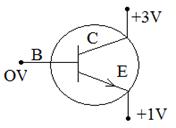CBSE Class 12-science Physics Transistors
- How do we bias the junctions of a transistor in common emitter configuration?
- What are Transistors?
- A P-N transistor is used in common - emitter mode in an amplifier circuit. A change of 40μA in the base current brings a change of 2mA in collector current and 0.04V in base -emitter voltage, Find (i) input resistance (ii) current amplification factor β. If a load resistance of 6 k oh m is used, then find voltage gain?
- Draw a labeled circuit diagram of a common emitter transistor amplifier. Draw its input and the output characteristics. .
- A transistor has a current gain of 30. If the collector resistance is 6kΩ, input resistance is 1kΩ, calculate its voltage gain?
- The input resistance of a silicon transistor is Ω Its base current is changed by 15μ A, which results in the change in collector current by 2mA. This transistor is used as a common emitter amplifier with a load resistance of 5k Ω. Calculate current gain (βac) transconductance and voltage gain.
- The base of a transistor is lightly doped. Explain why?
-
In the given figure, is (i) The emitter (ii) collector forward or reverse biased? Justify.
- Define current amplification factor in a common emitter mode of transistor?
- Calculate emitter current for which β = 100 IB = 20μA?





